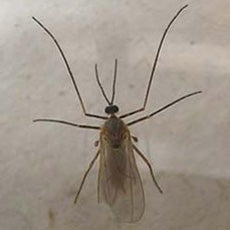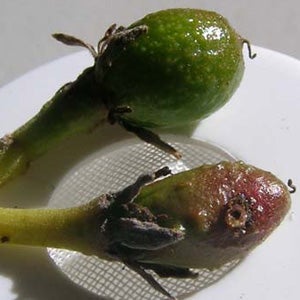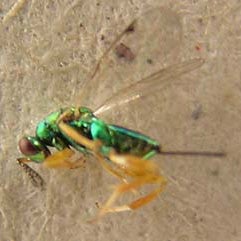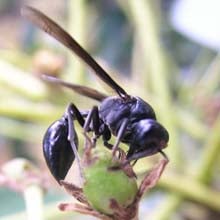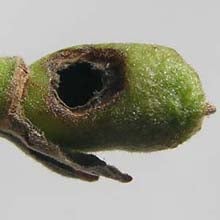Asphondylia websteri Felt (Diptera: Cecidomyiidae) attacking Hass Avocados
Prepared by Mark Hoddle, Extension Specialist and Director of Center for Invasive Species Research
mark.hoddle@ucr.edu
Contents
1 Introduction
2 Pest Identification and Biology
3 Monitoring and Biological Control
4 References
Introduction |
| Figure 1. Asphodylia websteri adult |
The exact home range of A. websteri is uncertain, but the southwestern USA and Mexico are thought to be areas constituting the natural range in North America as this midge was first recorded from this area in 1909 (Barnes 1946, Gagné & Orphanides 1992, Gagné & Woods 1988, Rogers 1972).
Asphondylia websteri Felt 1917 (Diptera: Cecidomyiidae), the alfalfa gall midge, is a polyphagous galling midge that attacks immature fruiting bodies of native (Gagné & Woods 1988) and exotic crop plants in the southwestern USA (Barnes 1946, Gagné & Wuensche 1986). This midge emerged as a pest of cultivated legumes in the southwestern USA in the early 1900's where larvae caused damaged to pods by feeding in the ovary and immature fruiting bodies. Galling of very young fruit can affect seed set and honey production. Damage to alfalfa at this time appeared to range from inconsequential to 20-30% damage being observed in some areas (Barnes 1946).
Prior to 1917, economic entomologists in the USA considered this midge to be A. miki Wachtl, a pest of legumes in central Europe, France, Italy, Hungary, Russia, and possibly England (Barnes 1946). Felt (1917) considered this highly isolated population of an invasive "European" pest in the southwestern USA "remarkable" but the identity of the midge could not be reassessed until a sufficient series of material was available for examination and comparison to European material. Reared material was made available in 1917 and sufficient morphological differences between the A. miki from Europe and the southwestern USA Asphondylia were determined to exist (e.g., smaller size, darker color, and less setae for the US species) that the US Asphondylia was named A. websteri after Professor Webster who supplied the type series of reared material for examination (Felt 1917).
There are over 250 described species of Asphondylia, with many additional known species that remain undescribed (Gagné & Waring 1990). Asphondylia spp. are cosmopolitan in distribution and the majority appear to be mono- or stenophagous (Barnes 1939). Some Asphondylia spp. exhibit sufficiently high host fidelity they have been considered as classical biological control agents for invasive weed species (Cruttwell-McFadyen & Bennett 1995). Other species of Asphondylia, like A. websteri and A. gennadii, are polyphagous, and in some instances, can be important pests on non-native crops (Gagné & Orphanides 1992, Gagné & Wuensche 1986, Rogers 1972).
Surveys for fruit feeding pests of Hass and non-Hass avocados over November-December 2007 in Guatemala detected large numbers of deformed avocado fruit < 2cm in length in a commerical Hass avocado orchard in Sumpango, Sacatepéquez. Visual examination of fruit indicated that up to 85% of "off bloom" fruit set from flowering that occurred over the period August-September was attacked despite prophylactic applications of broad spectrum insecticides. Deformed fruit did not set on trees and was observed to drop to the ground. Dissection of deformed fruit in the field revealed the existance of internally feeding larvae. Subsequent rearing of field collected material revealed that A. websteri was the agent responsible for fruit damage that was promoting premature abscission. The rearing and identification of A. websteri from Hass avocados in Guatemala is the first official record for this midge from Central America and the first time this insect has been recorded attacking immature fruit of avocados.
Pest Identification and Biology |
Adult Asphondylia websteri. Adult males and females of this midge are small and typically around 2.25 mm in length. Antenna are long often greater than 3/4 of the body length. Eyes are large and black, the thorax is a dark reddish brown with occassionally yellowish brown markings. Legs are brown in color, halteres are pale yellow, and the wings are hylaine almost without setae and characterized by a light brown costal vein.
|
Figure 2. An Asphondylia websteri escape tunnel entrance shown in a deformed fruit (bottom). |
Figure 3. A protruding pupal case from which the adult midge has emerged. |
Larvae and pupae. In Hass avocados, immature A. websteri feed in the ovaries of developing fruit. Female flies appear to lay one egg per fruit. Larvae complete development within fruit and create an escape tunnel in the side of the fruit from which the adult fly can emerge. The emergence tunnel is created by a "spatula", a structure on the head region of third instar larvae that is used to scrape away plant material until a thin exocarp wall is formed at the distal end of the tunnel. Pupation occurs within the central cavity of the deformed fruit. When the fully developed adult midge is within the pupal case the pupa advances to the end of the escape tunnel using abdominal spicules to gain traction within the tunnel. The pupa opens the necrotic entrance in the exocarp wall to the outside world by applying it pupal horns to the closed end of the tunnel and rotating its body about the longitudinal axis thereby cutting open the exit hole (Gagné et al. 2004). Once the circular tunnel entrance is open, the pupa advances partway out of the tunnel exit and the adult midge then emerges from the protruding pupal case. Typically, the deformed fruit dehisces shortly after the emergence of the adult fly, and drops from the tree. Subseqeuntly, abscissed fruit with protruding midge pupal cases can be collected from the ground.
Monitoring and Biological Control |
|
Figure 4. Hass fruit undergoing normal development (left), and fruit with A. websteri larvae developing inside them (right). |
|
Figure 5. Torymus sp. were amongst the parasitoids reared from A. websteri larvae. |
Feeding Damage. As larvae develop and feed internally, infested young Hass avocado fruit become misshapen acquiring a thin and elongated appearance. This shape is extremely characteristic for young avocados infested by A. websteri. Internally, the young avocado fruit is hollowed out by larval feeding. Gagné et al. 2004 mention that in avocado fruit attacked by Bruggmanniella perseae, a cecidomyiid from Colombia and Costa Rica, the central chamber in the fruit becomes colonized by the hyphae of what is presumed to be a symbiotic fungus. It was not noticed whether Hass avocado fruit in Guatemala attacked by A. websteri also promoted fungal growth in the central feeding chamber. A. websteri appears to be a pest mainly of small avocados that are set during the off bloom period, August through September, in Guatemlala. Depending on the site and the year, off bloom fruit damaged by A. websteri can range from 21-85%.
Natural enemies of Asphondylia websteri. Larvae of A. websteri were heavily parasitized by eight species of hymenopterous parasitoids: (1) Torymus solidaginis, (2) Torymus bedeguaris (group) (both Hymenoptera: Torymidae); (3) Rileya sp. (Hymenoptera: Eurytomidae); (4) Paragaleopsomyia sp. (Hymenoptera: Eulophidae), (5-7) three species of Galeopsomyia (Hymenoptera: Eulophidae), and (8) Lyrcus sp. (Hymenoptera: Pteromelidae). Descriptions and photographs of parasitoids reared from deformed Hass avocados in Guatemala that were infested with A. websteri is available.
In addition to parasitoids, larvae of A. websteri were attacked by Epipona guerini (Hymenoptera: Vespidae: Polistinae). Adult wasps were observed foraging in the study orchard, cutting open infested fruit with their mandibles, and extracting A. websteri larvae and eating them. The sides of fruit from which A.websteri were removed by E. guerini were characterized by large circular holes.
|
|
||
|
Figure 6. Epipona gueriniopening an immature Hass avocado fruit infested with a larva of Asphondylia websteri. |
Figure 7. Epipona guerini extracts Asphondylia websteri larvae from fruit and eat them. | Figure 8. Fruit from which Asphondylia websteri have been removed by Epipona guerini were characterized by large circular holes in the side of the fruit. |
References |
- Barnes, H. F. 1946. Gall midges of economic importance. Vol. II. Gall midges of fodder crops. Crosby Lockwood and Son LtD. U.K.
- Cruttwell-McFadyen, R. E., and F. D. Bennett. 1995. Potential biocontrol agents of Portulaca oleraceae L. from the Neotropics. Biol. Cont. 5: 189-195.
- Felt, E. P. 1917. Asphondylia websteri n. sp. J. Econ. Entomol. 10: 562.
- Gagné, R. J., and G. M. Orphanides. 1992. The pupa and larva of Asphondylia gennadii (Diptera: Cecidomyiidae) and taxonomic implications. Bull. Entomol. Res. 82: 313-316.
- Gagné, R. J., F. Posadam, and Z. N. Gil. 2004. A new species of Bruggmanniella (Diptera: Cecidomyiidae) aborting young fruit of avocado Persea americana in Colombia and Costa Rica. Proc. Entomol. Soc. Wash. 106: 547-553.
- Gagné, R. J., and W. M. Woods. 1988. Native American plant hosts of Asphondylia websteri (Diptera: Cecidomyiidae). Ann. Entomol. Soc. Am. 81: 447-448.
- Gagné, R. J., and A. L. Wuensche. 1986. Identity of Asphondylia (Diptera: Cecidomyiidae) on Guar, Cyamopsis tetragonoloba (Fabaceae) in the Southwestern United States. Ann. Entomol. Soc. Am. 79: 246-250.
- Hoddle, M. S. 2008. First record of Asphondylia websteri (Diptera: Cecidomyidae) infesting Hass avocados. Florida Entomologist 91: 501-503.

